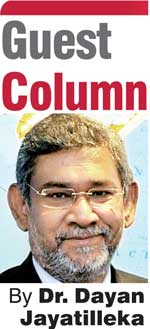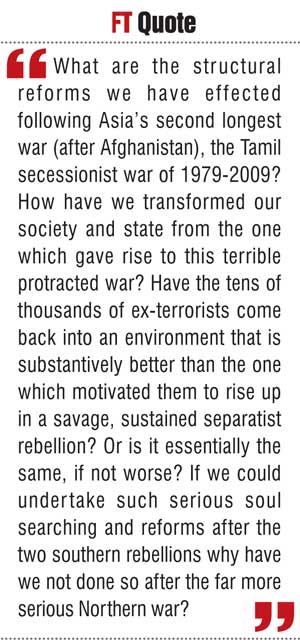Wednesday Jan 07, 2026
Wednesday Jan 07, 2026
Monday, 30 October 2017 00:00 - - {{hitsCtrl.values.hits}}
Hundreds of thousands of people, mostly young, died violently or were maimed, and tens of thousands disappeared, and unknown numbers were tortured, in the less than four decades between April 1971 and May 2009 on this small island.
Something must have been wrong, something must have gone wrong, somewhere, for all this horror to result among so much natural beauty and tranquility. We are all implicated in different ways and in different degrees. The least we can do is accept that there were huge mistakes and seek to rectify them through reform. For this, we must turn the searchlight inwards and not content ourselves with pointing the finger outwards.
After the April 1971 insurrection we implemented drastic reforms: a new, Republican Constitution, and two waves of Land Reform. After the 1986-1989 Southern insurrection we had the Youth Commission, the reintroduction of merit as the criterion of employment, the Janasaviya Poverty alleviation program, the Land Task Force to distribute uncultivated land, the free school uniforms and free school midday meals programs, the 200 garment factories, the massive housing programs, the 15,000 projects program.

What are the structural reforms we have effected following Asia’s second longest war (after Afghanistan), the Tamil secessionist war of 1979-2009? How have we transformed our society and state from the one which gave rise to this terrible protracted war? Have the tens of thousands of ex-terrorists come back into an environment that is substantively better than the one which motivated them to rise up in a savage, sustained separatist rebellion? Or is it essentially the same, if not worse? If we could undertake such serious soul searching and reforms after the two southern rebellions why have we not done so after the far more serious Northern war?
Northern angst
This is an island in anguish. Both South and North of the island are in pain. The North is in pain because it lost a war. It is also in pain because it feels that its ethnic kin have a better status elsewhere in the world and therefore it either needs a better status or should be permitted to have self-rule or an independent state of its own.
Continuing and losing the war was of its own choice. It backed a secessionist enterprise and continued to do so despite numerous chances of a negotiated peace including through Indian mediation and guaranteed by Indian peacekeeping. It backed a fascist–terrorist separatist formation and stayed loyal to its leadership when it had non-fascist alternatives. It still refuses to be critical of that ghastly fascist leadership and project. Therefore much of its angst is self-inflicted.
As for a related source of Northern angst, that of a large military presence which it views as occupation, it might wish to consider that the Union (Northern) armies stayed in the defeated Confederate South in large numbers for 12 years after the US Civil War.
As for the second source of Northern angst, that of insufficiency of political space and status, there too, the North has two options. One is to fight, especially during this season of constitutional change, for full integration and participation on the basis of non-discrimination and equality (the Civil Rights strategy), which should be easily feasible given the fact that the Tamil people are fully enfranchised.
If, as I have argued elsewhere, Tamil angst is due to lack of self-determination and sovereignty, it can be addressed by a strategy that calibrates the politically achievable according to the growing levels of consciousness of their allies, who have to be a majority of the Sinhala majority—which is manifestly not the case right now. This was the strategy adopted by the Sinn Fein/IRA in relation to the British Labor Party and Tony Blair.
However, Tamil angst remains unaddressed due mainly to a self-inflicted addiction: the persistent and continuous Northern adoption of a unilateral approach which fails the twin tests of realism and sensitivity to the electoral survival of its Southern ally (which explains the slightly lurid warning that President Sirisena gave his audience in Jaffna recently).
The Sinhala Extreme Right
Second only to the Tamil separatists in general and the Tamil Tigers in particular, the Sinhala Extreme Right has been the most negative and destructive force on this island for at least a century. Since the permanent interruption and derailing of the magnificently heroic anti-imperialist armed revolts of 1818 and 1848 by substituting for such rebellions, the religio-communal clashes of 1883, 1903 and 1915 right through Black July 1983 up to post-2009 Islamophobia, the ethno-religious Far Right has served to divide our people, derail their struggles and help imperialism.

S.W.R.D. Bandaranaike succumbed to the fundamentalist Right in 1957 and failed to implement the Bandaranaike-Chelvanayagam Pact, with disastrous results for the country in the form of Asia’s longest war apart from Afghanistan’s.
The hawkish Sinhala Right continued to do its damage in the 1980s, firstly with Black July ’83 and secondly when the Indian intervention of 1987, the resultant spike of the savage JVP uprising as well as its brutal suppression could have been avoided or minimised, had President Jayewardene been permitted to implement any one of several efforts at provincial devolution—Annexure C in 1984, the Political Parties Conference of June-July 1986, and the Dec 19thproposals of 1986.
Further damage was done by unilaterally postponing the promise given at the highest level, both to the TNA as well as India, to civilianise the Governorship of the Northern Province after the term of the ex-military governor had lapsed. I was around when on the occasion of the swearing-in of Chief Minister Wigneswaran at Temple Trees, the TNA leadership told President Rajapaksa and Lalith Weeratunga that a million votes could swing his way if he kept his promise and adopted a positive policy towards the Northern PC. This promise too was reneged upon and the military governor was given a second term. Had this not happened, Mahinda Rajapaksa almost certainly would have had his third term.
How can we tell the Sinhala Hard Right/Far Right/Extreme Right/Alt-Right/Radical Right from other brands of ideology and politics? I would submit that this line of demarcation is primarily but not solely the 13th Amendment, though the principle of Provincial devolution is a segment of that line of demarcation.
The Hard Right or Far Right, by definition, stands ideologically to the right of Mahinda Rajapaksa and indeed the Rajapaksas as a whole. The Rajapaksas weren’t and are not opposed to the13th Amendment and provincial devolution as such, though they may as individuals and at various times, prefer other solutions or forms of devolution. The Rajapaksas are populists and ‘statists’, but above all they intuitively pragmatic populists and instinctive ideological centrists, even when they may or may not be consistent moderates.
By contrast, the Sinhala supremacist Alt-Right is not. A litmus test is the Lessons Learnt & Reconciliation Commission (LLRC) Report. The LLRC was not only appointed by President Rajapaksa, its chairperson was someone so close to Mahinda Rajapaksa that he was the witness from the Rajapaksa side at the wedding of the former President. This was the legendary Attorney-General, CR “Bulla” de Silva.
Having been on the same team in Geneva, I came to know him as a tough-minded top official; hardly a liberal idealist. The rest of the LLRC team were also educated, intelligent, senior officials with international experience. The Report they produced was the distillation of decades of experience of the Sri Lankan state, looking back at the decades the country lost in the war, and making recommendation of how to stop future wars. The LLRC Report was welcomed and most cordially accepted by President Rajapaksa.
This was late 2011, and it was indeed the last chance. Opposition mounted from two quarters. One was the TNA and the NGOs, local and foreign. The other was the Sinhala ultranationalists. There was no objection from the international community from global East to West, South to North, including, most importantly, India. The only call was to speedily implement the LLRC Report. Implementation indeed began, coordinated and monitored by Presidential Secretary Lalith Weeratunga, but it was too slow, too fitful, too little, too late.
By 2012 we had lost India. The USA, spotting the change it had waited for and worked towards, moved against us in Geneva. India pivoted against us. Our global coalition, including our Third World and Nonaligned coalition, began to peel off. This was not only because India had turned against us, though that was a primary reason. It was also because we shifted to a different discourse in Geneva; not the one that we had adopted in 2007-2009 when we won on my watch.
By 2012, the discourse and actual behavior of delegations from Colombo in Geneva was that of the Sinhala supremacist Right. As a result we dismantled our broad united front, and met with a hat-trick of crushing defeats at the UNHRC in 2012, 2013 and 2014, paving the way for the diplomatic atrocity of the Ranil-Mangala sellout of October 2015.
Another litmus test which helps one identify the Sinhala Extreme Right is the highly selective use of the Paranagama Report or its avoidance or rejection altogether. The Paranagama commission was appointed by President Rajapaksa and given its second mandate by him. Its Report factually shreds the atrocious allegation of “genocide”, while acknowledging that “…there may have been long standing practices of religious and racial discrimination carried out by various governments towards minorities…” The denial of this reality of our post-Independence history is a hallmark of the Sinhala Far Right.
Nowhere close to a Middle Path
To this day, eight years after a 30-year war, one of Asia’s two longest (Afghanistan being the longest), the Sinhala Hard Right or Radical Right is nowhere close to a Middle Path. It does not recognise the need for “dialogue and accommodation”. It does not recognise any legitimate “grievances of the Tamil community” (LLRC Report) whatsoever. It doesn’t acknowledge any legitimate aspirations of the Tamils and or Muslims based on collective or individual identity. The only identity that seems to matter is that of the Sinhalese, and in actuality, that of the Sinhala Buddhists. This is far from being the lesson drawn by the LLRC.
The Sinhala Alt-Right does not see any need for “a political solution”. It insists that the Joint Opposition boycott the Constitutional assembly process and oppose the implementation of the 13th Amendment or unilaterally slash it to ‘13 minus’. Some prominent Alt-Right figures do not see the need for any kind of devolution, any kind of power sharing, at all—theirs is a ‘zero-devolution’ option. This a far cry from the LLRC formula (during the Mahinda Rajapaksa presidency) of “an all-inclusive political process” of “dialogue and accommodation” so as to achieve “a political solution” aimed at establishing “a multi-ethnic nation at peace with itself in a democratic Sri Lanka”.